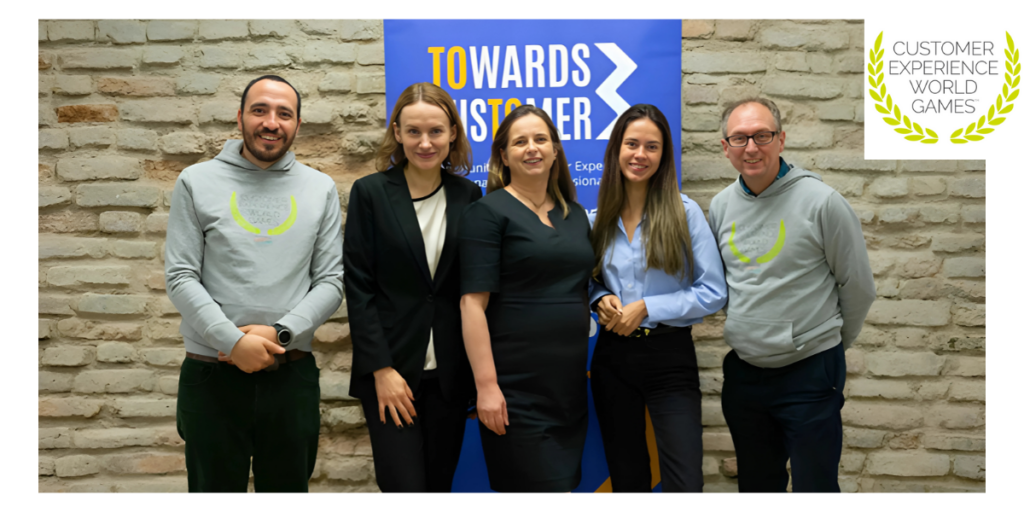How can a brand make an impression with customers when it operates in such a competitive and commoditised sector as telecommunications?
Branimir Spajic, director of the customer experience management department at Hrvatski Telekom, explains how his organisations has embraced CX to provide a competitive advantage.
CB. Where did you come from and your CX passion begin?
BS. I have a background in physics and computer science. When I finished college, I crossed the road to the Croatia Telecom building. I needed money to live. I went for an interview in my second year and started as a customer service agent.
There was no proactive selling at the time, so when I started to make sales, they realised I was a good sales person. I was getting the best results so was promoted to a senior agent. I was helping my colleagues with a ‘tips and tricks’ best practice pack.
My seniors recognised the value of what I had created and asked me to build a full programme to roadshow and educate other front line employees. It took me to 4 centers and I trained 600 people, 1 on 1 across four months. The results impressed me especially as they sustained and improved. My approach was to put service at the heart of the sale.
I was asked to meet the director of customer service in Zagreb. He valued the work and offered ,e a team leader. It was a big change personally, but I accepted and relocated to Zagreb with three days. This was the start of my journey.
After six months, I had developed the Deutsche Telecom programme called ‘sales force efficiency’, where every touch point is boosted for better sales. My initiative was taken broader, beyond the service center to across all channels. I was involved in leading this project. I pushed and fought for it to remain customer service centric. Over its two years it was really successful. It has evolved now to be personalised with customer stories, but it’s still in place and recognised as a working success.
CB. What role do you now hold and what would you see your responsibilities are – to the business and to the customer?
BS. Now I am the director of the customer experience department. I am responsible for all B2C and B2B leading CX design and projects related to CX improvement and performance. I am also responsible for the customer perspective for all touchpoints.
It’s also our responsibility to make sure the experience lives up to the brand promise. To achieve this we have created a CX framework to fit the brand values. For example, our Magenta 1 segment is a very highly valued segment, so they always ‘get more’. This means a premium experience. Others have since copied our approach. The ‘get more’ experience is something we future proof when making today’s decisions so it can be sustained.
CB. The telecom sector constantly changes; new competitors, new products, new propositions and increasing pressure from regulators. How does these impact the customer experience priorities?
BS. The telecom sector is highly competitive. Whatever we do we are fighting for every customer. Innovation differentiates in our sector. And CX is a crucial part of this. Sometimes customers say all telecoms are the same, so they are looking at the price. But honest customer feedback is the want to feel they are premium if they are paying more. They want us to deliver what we promise.
CX is crucial to differentiate. We can’t differentiate through products, so we need to be certain of the real needs of our customers. This will show you how to approach changes for the customer, what stands out in the market and where the priorities lie. in the market. And how to prioritise initiative. Sometimes this may just be about engaging employees to do something better. The solution is driven by the customer’s needs.
CB. How strategic is CX in your organisation? How does this align (or conflict) with other KPIs such as sales, renewals, etc?
BS. At the moment, responsibility for sales, renewals and CX are the same. It is great to be in this type of organisation. I believe it necessary for telcos’ to not choose one thing over the other. It’s not easy but you must collaborate across all three. If the customer has not been considered from the start of the design it will cost more to do it weakly without the customer and update it later to work.
CB. Telcos are a utility, much like insurance or energy. Is your CX focus just on ‘fixing’ broken customer journeys better than others?
BS. We have three stages.
- First we started fixing the basics. This meant understanding the end to end process, setting up customer journey maps and implementing measures to fix these.
- The second part was to establish an experience platform. By which I mean making life easier for customers through touch points you have across processes and products by managing and exceeding expectations.
- Finally, the level of branded customer experience design, making it personal and empathetic to customers’ individual situations.
By delivering integrity and resolve into your CX, it affords you the possibility to design branded CX. it is at this third level only you will differentiate on CX. but all of this is necessary to be a success.
CB. Are the needs of Croatian telco customers different from others? Does age play a part in requirements?
BS. Croatian customers love to talk to real people. For us this means our agents. So any kind of digitisation means we have to really address problems, and educate customers in the advantage if we want to see value from this alternative.
We have created digital platforms for services to move from analogue but at the same time we address key problems. You have to ensure your digital journeys are really focussed on first contact resolution to overcome the customer habit of making contact with agents. We are sharing the same problems with our colleagues across the globe.
CB. What are the three most important CX activities you undertake at Hrvatski Telekom?
BS. We focus on three things:
- First, simplification in every direction of the experience, including products and processes.
- Second, digitisation only happens when it provides a better enabler for the improved experience.
- And of course, provide the best possible network experience.
CB. How do you keep your staff engaged in CX – from the boardroom through to front line agents?
BS. A crucial part of this has been sharing customer stories. All employees have to be present on the front line so they can listen into calls. It’s important we experience what our customers experience; it’s the best engagement tool you can encounter to understand what it really feels like.
We encourage staff to work across different departments. Then, they can imagine the products, processes and experience we design for our customers and why they are important to them.
CB. You are part of the larger Deutsche Telekom European group. Are you able to share and apply learning across borders or is CX country specific in telco?
BS. Yes. We have a CX community across Deutsche Telekom. We organise workshops and conferences to exchange best practice for issues, and then localise these by market. It’s a really great opportunity to learn from the experiences of others with similar challenges. It’s really helpful.
CB. Overall in CX, what has been your biggest success so far?
BS. It has to be making an impact by successfully motivating the whole team. It’s not easy when you have short term goals, but we know CX is a long journey. It’s not a sprint, but a marathon. This can make success hard to show from day to day, because you often have to wait for results. So you must find something to motivate colleagues on a daily basis. This means finding specifics related to their job purpose and how that impacts the customer so they can see the value they create. We can see this in the feedback from customers.
It’s very rewarding when you review a journey to be closer to the customer, learn from mistakes and be more agile in our response. When you come in the next day and see the results in your VoC it boosts you emotionally to do more.
CB. How are you measuring customer success? Are you winning?
BS. We have two lead KPIs. One is CSAT, measuring the brand experience after every key touchpoint, in real-time. The second is a loyalty measure we track periodically. Any negative feedback we receive we individually case manage through comments and call back. We really appreciate every piece of feedback so prove we act upon it, to encourage customers to tell us what matters more often.
CB: Are you able to take CX ideas from other sectors and apply them to telecoms?
BS. Yes. This is something we look for in research papers and conferences, especially in Europe. We see the potential we can learn from other industries. For example we redesigned our bill which came from studying others standards.
CB. So what’s next for CX in telco?
BS. How to put the data to better use to serve customer improvements. Where is the empathy and personalisation in data? Ideas are there if you look. So, it’s about how we address that.
CB. Which companies do you look to for inspiration? Who impresses you?
BS. I like several, but I’ll use Amazon. I know it’s popular but I’m impressed by how it addresses two levels of experiential need. It’s their approach. I appreciate the transparency, which I now expect from other relationships. And they are eager to get my feedback and react immediately. They do this and deliver so never fail in delivering a personalised relationship with me.
CB. Thank you for your time. If our readers are looking to embark on a customer experience strategy, what advice would you give them to increase their chances of success?
BS. Think big, but start small. Best advice I had in my career. You have to be certain of what you do because everyone expects immediate results. You don’t need a data lake or big customer tech platforms. This is not your customer experience strategy. Start small with bits and pieces. And deliver results so you gain support and confidence to scale it up until you reach your vision.
CB. Well, thank you Branimar. Having met a few times it was great to hear the full story which I am sure will inspire others. All the best with your continued success.




